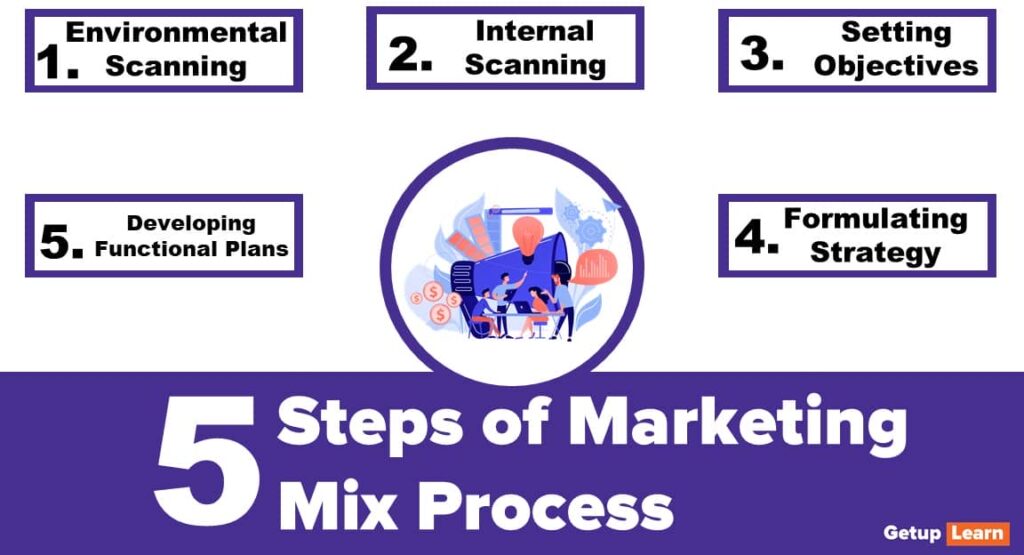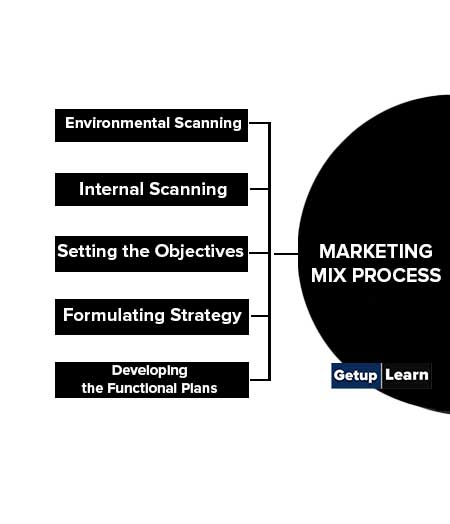Table of Contents
Marketing Mix Process
A firm’s marketing efforts should starts and end with the customers. A marketing mix is an important tool used by the marketing manager in formulating marketing planning to suit the consumer’s needs.

There is a need for a well-defined marketing mix to attain the goal of the marketing department of the firm. Hence the formulation of the marketing mix is also one of the emerging functions of marketing management. The steps involved in the marketing mix process are as follows:
- Environmental Scanning
- Internal Scanning
- Setting the Objectives
- Formulating Strategy
- Developing the Functional Plans

Environmental Scanning
The study of marketing environment analysis helps to locate marketing opportunities and discover unsatisfied consumer demand.
It also undertakes consumer sensing, reactions of the consumer to its products and tries to locate the causes of the consumer’s patronage of a particular brand and who remains closest to the consumer, and why.
Internal Scanning
Internal scanning is the process of assessing the firm’s strengths and weaknesses and identifying its core competencies and competitive advantages .while environmental scanning may help to identify the various possible opportunities in areas of interest to the firm.
Setting the Objectives
Objectives are the main focus of the business unit which explores the functions and performance. Hence, there is a well-defined objective should be established The business unit has to develop its marketing objectives after weighing the opportunities available in the environment, the treats, the forces of competition, the resources and capabilities of the unit, and its marketing organizations.
Formulating Strategy
The marketing strategy should e aligned with corporate and business level strategies .marketing strategy formulation is the core of the marketing mix.
The marketing program of an individual product must be consistent with the strategic direction, competitive trust and resources allocation decided on at a higher management level.
Developing the Functional Plans
The detailed functional plans will spring from and be in true with the marketing objectives and marketing strategy of the firm. There is a need for well-defined functional plans that leads to a systematic and structured flow of the functions in the business concern.
There is a separate plan for each component of the marketing mix viz product, price, place, and promotion. And at the same time, each component must have a predetermined with organized efforts.
Limitations of Marketing Mix
The marketing mix (4 P’s) was more useful in the early 1920s when production concept was in and physical products were in larger proportion. Today, with the latest marketing concepts, the marketing environment has become more integrated.
So, in order to extend the usefulness of the marketing mix, some authors introduced a fifth P and then seven P’s (People, Packaging, and Process). But the foundation of Marketing Mix still stands on the basic 4Ps.
These four P’s are the parameters that the marketing manager can control, subject to the internal and external constraints of the marketing environment. The goal is to make decisions that center the four P’s on the customers in the target market in order to create perceived value and generate a positive response.
What is the process of marketing mix?
These are the steps involved in the marketing mix process:
1. Environmental Scanning
2. Internal Scanning
3. Setting the Objectives
4. Formulating Strategy
5. Developing the Functional Plans.
What are the limitations of marketing mix?
These four P’s are the parameters that the marketing manager can control, subject to the internal and external constraints of the marketing environment. The goal is to make decisions that center the four P’s on the customers in the target market in order to create perceived value and generate a positive response.

